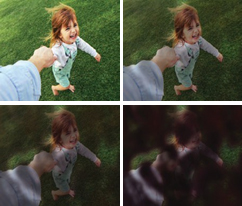Diabetes and Your Eyes
Care instructions
What is diabetic retinopathy?
Diabetic retinopathy is a painless eye disease of the retina caused by diabetes. The retina is the layer of tissue at the back of the eye. It works like a camera to capture information about what you see.
Diabetes can cause damage to the tiny blood vessels in the retina. This can lead to changes in your eyesight such as:
- seeing dark, floating spots
- having blurry vision
- having trouble seeing well at night
- blindness
When you have diabetic retinopathy, your eyesight gets worse over time if it’s not treated.
Diabetic retinopathy is the most common cause of blindness in working-age people.

Changes that happen over time with diabetic retinopathy
Credit: Canadian Ophthalmological Society
Why is it important to have regular diabetes eye health exams?
Having a diabetes eye health exam each year helps find diabetic retinopathy early. You may not notice changes to your eyesight until diabetic retinopathy is advanced. This is why it’s important to have a diabetes eye health exam each year.
If there is a problem with your eyes, you may need treatment to slow or prevent the loss of your eyesight.
What happens during a diabetes eye health exam?
The diabetes eye health exam is done by an optometrist (a doctor trained in diagnosing and treating eye diseases) or an ophthalmologist (a doctor trained in surgery and other advanced treatment of eye diseases). You don’t need a referral from your doctor to see an optometrist, but you need one to see an ophthalmologist.
During a diabetes eye health exam, your eyes may be dilated. This is done with eye drops that make your pupils (the black, centre part of the eye) larger. Having your eyes dilated lets your optometrist or ophthalmologist have a clear view of the retina at the back of your eye. Your optometrist or ophthalmologist will let you know if your eyes will be dilated during the appointment.
If your eyes are dilated, you may be sensitive to light and have blurry vision for several hours. You won’t be able to drive for a few hours after your eyes are dilated. You will need someone to drive you home after the exam.
Do I need a referral to see an optometrist?
You don’t need a referral to see an optometrist, but it is helpful to tell the optometrist who your family doctor is so they can send them a report with the results of your diabetes eye health exam. Use the Eye Health Referral Form to make sure your family doctor gets the report from the optometrist.
To find an optometrist near you, go to the Alberta Association of Optometrists.
Is the diabetes eye health exam covered in Alberta?
Yes, the diabetes eye health exam is covered by Alberta Health Care. When you book your appointment, you must say that you have diabetes and would like to book a “diabetes eye health exam”.
How is a regular eye exam different from a diabetes eye health exam?
The diabetes eye health exam further assesses the areas of the eye that can be affected by diabetes, including the retina. If your eyesight isn’t perfect, you may get a prescription for lenses to correct it.
What eye exams are covered in Alberta?
The diabetes eye health exam portion of the regular eye exam is covered for all ages by Alberta Health Care. A regular eye exam is not covered by Alberta Health Care if you’re between the ages of 19 and 64. Learn more about coverage for vision care in Alberta.
Depending on the date of your last regular eye exam, your optometrist may recommend a regular eye exam before the diabetes eye health exam.
If you want to have only the diabetes eye health portion of the exam, you must say you have diabetes when booking your appointment and request to have only the diabetes eye health exam portion of the regular eye exam.
How often do I need a diabetes eye health exam?
You should have a diabetes eye health exam once a year or as often as your optometrist or ophthalmologist says you need one. But if you have changes to your eyesight, make an appointment to see your optometrist or ophthalmologist right away.
Remember, you may not notice changes to your eyes or eyesight so it’s important to go for regular diabetes eye health exams.
What can I do to lower my risk of diabetic retinopathy?
To lower your risk of diabetic retinopathy:
- Keep your blood glucose (sugar) level, blood pressure, and cholesterol levels at your target range. Your healthcare provider will tell you what your target ranges are.
- Have regular diabetes eye health exams.
What happens if I have diabetic retinopathy?
Not everyone with diabetic retinopathy needs treatment. If you need treatment for diabetic retinopathy, you’ll be referred to an ophthalmologist.
To see this information online and learn more, visit MyHealth.Alberta.ca/health/pages/conditions.aspx?Hwid=custom.ab_diabetes_retinopathy_inst.

For 24/7 nurse advice and general health information call Health Link at 811.
Current as of: February 16, 2024
Author: Diabetes, Obesity & Nutrition Strategic Clinical Network / Neurosciences, Rehabilitation & Vision Strategic Clinical Network, Alberta Health Services
This material is not a substitute for the advice of a qualified health professional. This material is intended for general information only and is provided on an "as is", "where is" basis. Although reasonable efforts were made to confirm the accuracy of the information, Alberta Health Services does not make any representation or warranty, express, implied or statutory, as to the accuracy, reliability, completeness, applicability or fitness for a particular purpose of such information. Alberta Health Services expressly disclaims all liability for the use of these materials, and for any claims, actions, demands or suits arising from such use.
